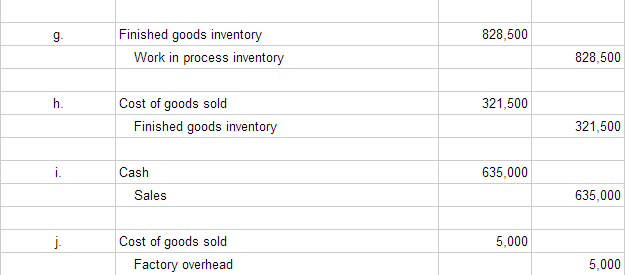
In other words, finished goods are complete and ready to be sold units, which are in the company’s possession. These units are also referred to as merchandise, which is mainly owned by the retailer. Finished goods are typically aggregated into the Inventory line item in the balance sheet. Since finished goods are generally presumed to be sellable within finished goods accounting one year, this line item is classified as a current asset on the balance sheet. Use barcode scanning or radio-frequency identification (RFID) tagging to allow your staff to easily record and track stock levels and locations. A large electronics company has $2,000,000 worth of finished smartphones in inventory at the beginning of the quarter.
Finished goods inventory definition

Chemical conversion is any process in which the substances used in the manufacturing process undergo a molecular change in composition. This classification includes the manufacturing of chemical ingredients as well as the blending and mixing of the ingredients. Depending on the type of chemical the employer manufactures, raw materials may be in the form of gas, liquid or in solid form such as crystals or powder.
Sales and Revenue Generation
With Deborah Gemborowski, CPA, P.C., you can focus on running your business, while we keep your accounting in line. Work performed by a subcontractor that becomes part of the finished product is considered exempt production work. Computer equipment used in collateral or administrative functions (such as computer equipment linked to production equipment that merely functions to collect data for administrative use) does not qualify for the exemption. Having a buffer of finished goods also allows you to react quickly to emerging customer preferences. For example, if a particular fitness tracker surges in popularity, you’ll have the inventory to capitalize on the demand and maximize your sales potential.
How does understanding finished goods inventory help your business?
This is where the raw materials are prepared for various manufacturing processes that change their properties, shape, or function. The process of transforming raw materials into finished goods inventory involves several steps, as described below. That’s why managing inventory efficiently is a crucial process for optimising production and sales performance in your business.
This classification includes sifting, grinding, pulverizing, drying, liquefying, and blending ingredients with or without heat. Chemicals are then filled in drums, containers, bottles or placed in packages and either shipped or delivered to the employer’s customers by the employer’s drivers or outside concerns. When you manage your finished goods inventory effectively, you free up cash that would otherwise be stuck in unsold products.
Also contemplated under this classification are employees who are employed by others contracted with a hotel or motel operation to operate the golf courses for the hotels or motels guests. A clerical office employee must work in an area separated by floors, walls, partitions, counters or other physical barriers. These employees are not to be regularly exposed to the operative hazards of the business. Code 8810 is subject to the Standard Exception Manual Rule IV – Classifications of this Manual. Shall not be assigned to an employer engaged in the manufacturing of chemicals.
By using an automated inventory system, you can ensure they have sufficient stock and manage production schedules effectively. Smaller businesses can also cut down on costs this way by not having to hire for such short high-demand periods. This method prevents tying up current assets in unnecessary inventory, reducing material waste, and improving cash flow.
They know they can rely on you to have the items they need in stock, fostering brand loyalty and repeat business. During the month, your talented team crafted another $25,000 worth of beautiful jewelry and sold $22,000 worth of jewelry. To help you understand more and apply this formula, we take an example of a textile company X producing silk. At the end of 2020, factory X had 1000 finished pieces of silk in stock that needed to be sold. To manage these products effectively, you need to balance having enough stock to meet customer needs and not overstocking.
Shall not be assigned to a risk engaged in operations described by another classification unless the operations subject to Code 2417 are conducted as a separate and distinct business. Timekeepers and watch guards employed by construction or erection contractors are present during the construction or erection operations. Watch guards also work nights, weekends and holidays to assure that vandalism and theft does not occur. Code 2593 applies to employers engaged in cleaning carpets, blinds, rugs and/or upholstery at customers’ locations or in their own shop. Carpentry repair and/or remodeling of commercial buildings and structures and dwellings that exceed three stories in height are also assigned to this classification.
ABC analysis helps prioritize inventory management by categorizing items based on their value and importance. “A” items are high-value products with lower sales frequency, “B” items are moderate in both value and sales frequency, and “C” items are low-value but sell in higher volumes. In ABC analysis, the goal is to focus more attention on managing “A” items so that you can optimize inventory investment and reduce carrying costs.
- Metal eraser tips are stamped out on presses, fitted with rubber erasers and attached to the pencils.
- Code 3385 applies to employers engaged in manufacturing watches, watch movements and clocks.
- Let’s look at some examples of how this formula can be applied in real life.
- Maintenance employees maintain the campgrounds, and/or the equipment used by the members.
This ensures you never run out of stock and helps maintain a smooth supply chain. Additionally, keeping a safety stock buffer can protect against unexpected spikes in demand or unpredictable delays in production. One of the first activities of a manufacturing business is to obtain the raw materials needed to produce a finished good. These raw materials can be purchased from suppliers or extracted from natural resources. Raw materials are the basic inputs that are used to produce finished goods.
